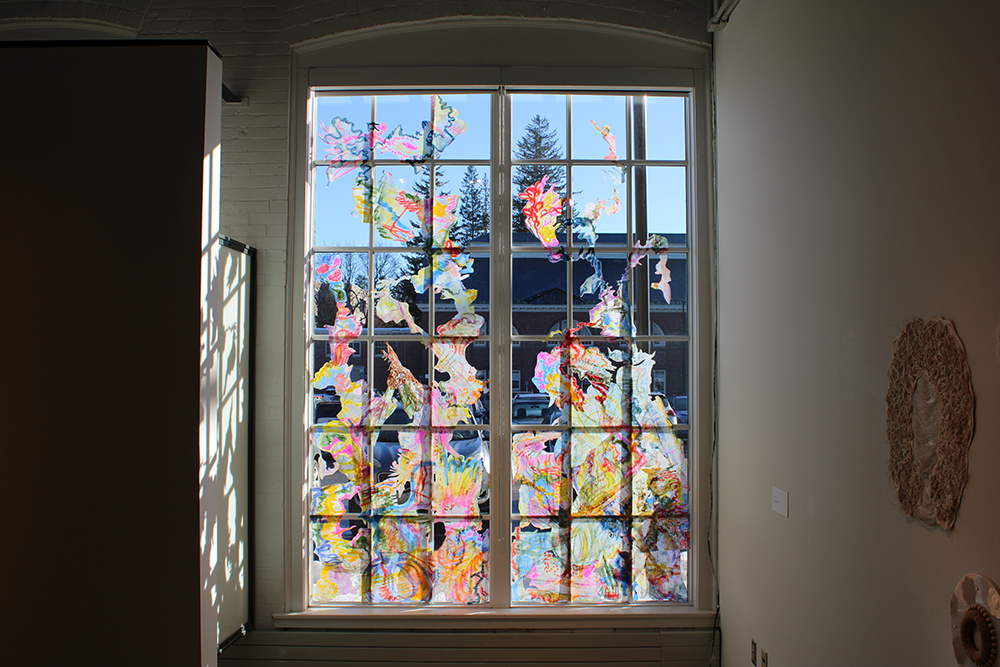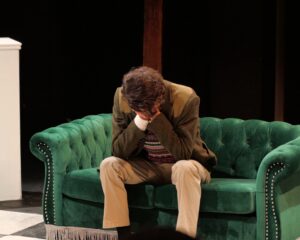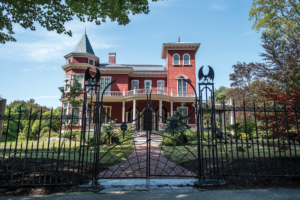The University of Maine’s Lord Hall Gallery has officially opened up the 2023 Faculty Exhibition on Feb. 3, and will run to March 17. Gallery director Diana Bumbach held an opening reception last Friday, to welcome visitors and usher in a new year of exceptional and diverse artwork from the university’s Department of Art with more events to come.
Bumbach is an assistant professor of art at UMaine and began her role as Director of Galleries when she arrived in Orono in August 2022. She has had solo exhibitions of her own on other campuses, including the University of South Carolina and Colorado State University, as well as other countries such as the Netherlands and South Korea.
One of her pieces at this year’s Faculty Exhibition, called “First and Last” explores the deeply personal idea that touches on the state of motherhood with the creative use of old collected materials. The use of old onesies, wool, plexi and nylon fasteners help to create a new handmade material. This material was then used to create circle-like sculptures, which are connected by wool to resemble an umbilical cord.
“The process of making this piece was slow and methodical, even meditative at times. It functioned as a farewell to that portion of my life, the childbearing years” says Bumbach, “I hope that the piece makes the viewer curious about a number of things including the materials, the title, the radial symmetry, the doubling effect, the process, the role of shadow, the elements that break out of the frame, and much more.”
Susan Camp showcases her environmental roots with her gourd sculptures. “Angel” and “Vessel 3” were created by growing gourds in special molds, allowing for unique shapes to be made for each hybrid-gourd form. These pieces are created and molded to explore ideas of gendered relationships and the dangers of human manipulation and control.
Another piece that uses natural materials is seen with the large pine branches being used in “Illuminations” by Sam Jones. The use of pigments to illuminate the bug trails on the wood helps the piece stand out, while also drawing inspiration from the philosophy of vital materialism, which applies that any and all abiotic matter in nature is alive. The use of shoji paper in the window piece “Residual Creatures” draws inspiration from 19th Century Spiritualism and French Surrealism. Viewing this piece during morning hours, when the sun illuminates it through the window, makes it feel more alive.
One of the more large scale pieces that visitors will notice is a constructed mobile lab containing all sorts of materials. Associate Professor of Research Susan Smith, in collaboration with artist Reed Hayden, created the piece “Radical Gardening: practice based research” as a way to preserve a dying sustainability practice. The piece’s main focus is immersion, as the viewer observes the gathered soils and plant matter from contaminated sites such as schools, factories and strip malls that are located from Maine to Texas.
Robert Pollien’s series of drawings using graphite and chalk make direct observations of our natural surroundings. In his piece “Oak Hill Bluff” Pollien wanted to portray an empty landscape, hoping for consideration of the land, or a sense of place or belonging. The framing of the piece lets the viewer observe the landscape as if they are looking through a window, to have more consideration for nature as a whole.
Artist and painter Tim Conte aims to be an attentive eye as he watches the day’s changing light and the activity it reveals. In his oil paintings, and especially in “The Aura” Conte wanted to focus on the patterns of light, and how it affected the environment, in order to create an effective and captivating atmosphere for the viewer.
A collection of baseball glove photos can be observed in a series of portraits by Matt Smolinksy. In the piece “Orono Varsity Baseball Gloves #1-#9” Smolinsky captures his time as an assistant coach while at Orono High School. The clean layout shows each photograph side by side, and the amount of wear and tear that can be observed in each glove can also be observed. Smolinsky wanted to represent the time, experience and dedication that each player shows for their sport.
The art gallery also displays digital and electronic mediums which communicate relevant ideas. Digital artist and animator Giles Timms showcases this in his animation “touch my human” which was created using a number of different digital media software tools. The animation touches on themes of modern life, the age of information, and the turbulence of the COVID-19 era we live in.
Another very unique piece is of Nate Aldrich’s “The Soundscape composer” which is a computer program with a fully controllable audio file database. First developed in 2005 for use at the Opera House Arts in Stonington, ME, the software has gone through numerous iterations since then. Users are given full ability to pause and play an array of sound files. There are also settings for volume control and pitch shifting each sound file, meaning that repeated user action is encouraged.
Aldrich is also expected to appear alongside Steven Norton and Leslie Ross in an upcoming gallery performance, scheduled for Feb. 23 at the Lord Hall Gallery. The trio of musicians will integrate live performance into the exhibition.
“Rather than having it function as background noise for the reception, we agreed that the performance deserved to be a stand-alone event. Aldrich Norton & Ross make experimental improvisational music which includes both electronic and instrumental components,” Bumbach said.
The Gallery is located in Lord Hall and is open every weekday from 9 a.m. to 4 p.m.










